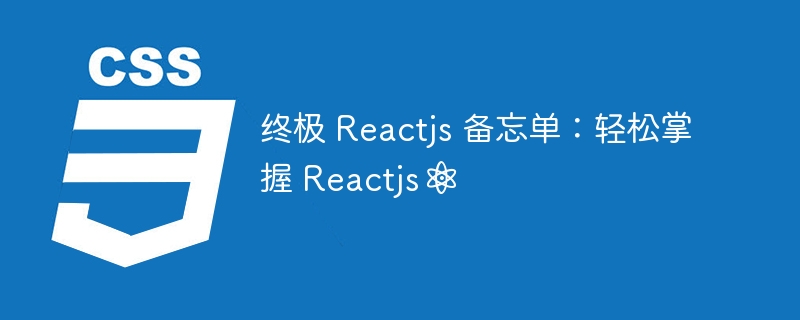终极 Reactjs 备忘单:轻松掌握 Reactjs⚛️

介绍
react.js 已成为现代 web 开发中用于创建交互式和动态用户界面的主要内容。其基于组件的架构通过提供声明性 ui 并利用虚拟 dom 的概念,简化了单页应用程序 (spa) 的开发。本备忘单旨在指导您了解 react.js 的基本知识,从了解基础知识到掌握高级技术。无论您是初学者还是希望提高自己的技能,本指南都是您掌握 react.js 的首选资源。
1. 了解 react.js 的基础知识
组件: react 应用程序的构建块,组件封装了 ui 元素的结构和行为。它们可以简单也可以复杂,并且可以提高可重用性。
function welcome(props) {
return <h1>hello, {props.name}</h1>;
}
jsx (javascript xml): jsx 允许您直接在 javascript 代码中编写类似 html 的语法,使其更直观、更易于使用。
const element = <h1>hello, world!</h1>;
虚拟 dom:react 的 virtual dom 是实际 dom 的轻量级副本,它允许高效的更新和渲染,从而提高应用程序性能。
2. 必要的工具和库
babel: 一个 javascript 编译器,使您能够编写现代 javascript 代码(包括 jsx),并将其转换为浏览器兼容的版本。
// babel transforms this jsx: const element = <h1>hello, world!</h1>; // into this: const element = react.createelement('h1', null, 'hello, world!');
webpack: 一个模块捆绑器,可帮助管理项目资产和依赖项,优化它们以实现高效加载。
redux: 一个状态管理库,可确保一致且可预测的应用程序状态,通常与 react.js 一起使用。
import { createstore } from 'redux';
function reducer(state = {}, action) {
switch (action.type) {
case 'increment':
return { count: state.count + 1 };
default:
return state;
}
}
const store = createstore(reducer);
3. 功能组件和钩子
函数式组件是简单、可重用的函数,它们接受 props 并返回 jsx。它们因其简单性和易于测试而受到青睐。通过使用 react hooks,您可以管理功能组件内的状态和生命周期方法,使它们更加强大。
import react, { usestate } from 'react';
function counter() {
const [count, setcount] = usestate(0);
return (
<div>
<p>you clicked {count} times</p>
<button onclick="{()"> setcount(count + 1)}>click me</button>
</div>
);
}
关键挂钩:
- usestate: 管理功能组件内的状态。
- useeffect: 处理数据获取或订阅等副作用。
useeffect(() => {
document.title = `you clicked ${count} times`;
}, [count]);
- usecontext: 提供了一种通过组件树传递数据的方法,无需手动向下传递 props。
4. 使用 jsx
jsx 允许您将类似 html 的语法与 javascript 表达式混合在一起。此功能使您的组件更加动态和交互。使用 jsx 有条件地渲染元素、映射数组以及将变量直接嵌入到您的 ui 中。
const user = {
firstname: 'harper',
lastname: 'perez'
};
const element = (
<h1>
hello, {formatname(user)}!
</h1>
);
5. 属性(道具)
props 是一种将数据从父组件传递给子组件的方法,使您能够控制子组件的行为和外观。 props 使您的组件可重用且可维护。
function greeting(props) {
return <h1>hello, {props.name}</h1>;
}
// usage
<greeting name="sara"></greeting>
6. react 中的样式
内联样式:使用 javascript 对象直接在组件中定义样式。内联样式可以根据组件状态或 props 动态调整。
const divstyle = {
color: 'blue',
backgroundcolor: 'lightgray',
};
function styledcomponent() {
return <div style="{divstyle}">styled with inline css</div>;
}
css-in-js 库: styled components 或 emotion 等库允许您在 javascript 代码中编写 css,将样式和逻辑封装在一起以实现更好的可维护性。
import styled from 'styled-components'; const button = styled.button` background: palevioletred; color: white; font-size: 1em; margin: 1em; padding: 0.25em 1em; border: 2px solid palevioletred; border-radius: 3px; `;
7. 状态管理
状态是控制组件行为和渲染的数据。使用 usestate 钩子来管理本地组件状态,并使用 setstate 在状态改变时触发重新渲染。
function example() {
const [state, setstate] = usestate({ count: 0 });
return (
<div>
<p>you clicked {state.count} times</p>
<button onclick="{()"> setstate({ count: state.count + 1 })}>
click me
</button>
</div>
);
}
8. 处理事件
react 提供了一种通过事件处理程序处理用户交互的简单方法。将事件处理程序绑定到您的组件方法,并使用事件对象来管理用户操作,例如单击、表单提交和输入更改。
function handleclick(e) {
e.preventdefault();
console.log('the link was clicked.');
}
<a href="#" onclick="{handleclick}">click me</a>
9. 条件渲染
条件渲染允许组件根据特定条件渲染不同的输出。利用 javascript 的条件语句(例如 jsx 中的 if-else 或三元运算符)来动态呈现内容。
function greeting(props) {
const isloggedin = props.isloggedin;
if (isloggedin) {
return <h1>welcome back!</h1>;
}
return <h1>please sign up.</h1>;
}
10.反应路由器
react router 使您能够创建具有多个视图和无缝导航的 spa。定义路线并将其链接到组件,以允许用户轻松浏览您的应用程序。它还支持动态路由和嵌套路由,增强应用导航的灵活性。
import { BrowserRouter as Router, Route, Link } from 'react-router-dom';
function App() {
return (
<router><div>
<nav><link to="/">Home
<link to="/about">About
</nav><route path="/" exact component="{Home}"></route><route path="/about" component="{About}"></route>
</div>
</router>
);
}
结论
掌握 react.js 打开了创建强大且高效的 web 应用程序的大门。本备忘单涵盖了您需要了解的基础知识、工具和高级概念。不断练习,了解最新趋势,探索庞大的 react.js 生态系统,以作为 react 开发者继续成长。
